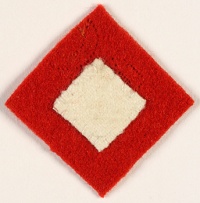
The 4th Infantry Division was a regular infantry division of the British Army with a very long history, seeing active service in the Peninsular War and Waterloo Campaign, the Crimean and Boer Wars and both World Wars. It was disbanded after the Second World War and reformed in the 1950s as an armoured formation before being disbanded and reformed again and finally disbanded on 1 January 2012.

The 11th Armoured Division was an armoured division of the British Army which was created in March 1941 during the Second World War. The division was formed in response to the unanticipated success of the German panzer divisions. The 11th Armoured was responsible for several major victories in the Battle of Normandy from in the summer of 1944, shortly after the Normandy landings, and it participated in the Allied advance from Paris to the Rhine, the Rhine crossing in March 1945. It was disbanded in January 1946 and reformed towards the end of 1950. In 1956, it was converted into the 4th Infantry Division.

The 38th (Irish) Brigade, is a brigade formation of the British Army that served in the Second World War. It was composed of North Irish line infantry regiments and served with distinction in the Tunisian and Italian Campaigns. Following the end of the war, the brigade was disbanded, but was reformed in sixty years later in 2007 and remains the regional formation for Northern Ireland.

The 6th Armoured Division was an armoured division of the British Army, created in September 1940 during the Second World War and re-formed in May 1951 in the UK.

The 23rd Armoured Brigade, originally formed as the 23rd Army Tank Brigade, was an armoured brigade of the British Army that saw service during the Second World War. The brigade was a 2nd Line Territorial Army (TA) formation. It was reorganised and renamed the 23rd Armoured Brigade, when it was assigned to the 8th Armoured Division, although it never operated under command of the division.

The 8th Armoured Division was an armoured division of the British Army during the Second World War. It was deployed to Egypt in June 1942 but never operated as a complete formation and was disbanded in January the following year.

The 9th Armoured Division was an armoured division of the British Army, raised during the Second World War. It never saw active service during the war as a complete division.

The 10th Armoured Division was an armoured formation of division-size of the British Army, raised during the Second World War and was active from 1941–1944 and after the war from 1956–1957. It was formed from the 1st Cavalry Division, a 1st Line Yeomanry unit of the Territorial Army (TA) which had previously been serving in Palestine. The division was converted from cavalry to armour and redesignated from 1 August 1941.

The 42nd Armoured Division was an armoured division of the British Army raised during the Second World War.

The 12th Armoured Brigade Combat Team, formerly the 12th Armoured Infantry Brigade, is a regular brigade of the British Army which has been in almost continuous existence since 1899 and now forms part of 3rd Division.

The 145th Infantry Brigade was a regional brigade of the British Army that saw active service in both the First and the Second World Wars, disbanding in 1943 and being reformed in the 1990s. The Brigade was renamed Headquarters 11th Infantry Brigade and Headquarters South East in October 2014.

The 6th Infantry Brigade was a regular infantry brigade of the British Army that was in existence during the Second Boer War, the First World War and the Second World War and later formed part of British Army of the Rhine.

The 3rd County of London Yeomanry (Sharpshooters) was a Yeomanry regiment of the British Army. It was raised in 1901 from Second Boer War veterans of the Imperial Yeomanry. During the First World War it served dismounted at Gallipoli, was remounted to serve in Macedonia, Egypt and Palestine, before being converted to machine gunners for service on the Western Front. 2nd and 3rd Line units remained in the United Kingdom throughout.

The Northamptonshire Yeomanry was a Yeomanry regiment of the British Army, formed in 1794 as volunteer cavalry. It served in the Second Boer War, the First World War and the Second World War before being reduced to squadron level in 1956. It ceased to have a separate existence in 1971.
During the Second World War the British Army deployed armoured divisions and independent armoured and tank brigades.
The 33rd Army Tank Brigade was an armoured brigade formation of the British Army raised during the Second World War.
The 209th Infantry Brigade was a Home Defence formation of the British Army during the Second World War.
The Huntingdonshire Cyclist Battalion was a bicycle infantry battalion of the British Army. Formed in the Territorial Force in February 1914, it remained in the United Kingdom throughout the First World War. After the war, in 1920, it was converted to infantry and became the 5th (Huntingdonshire) Battalion, Northamptonshire Regiment, in the Territorial Army. The battalion saw extensive service in the Second World War, fighting in France in 1940, Tunisia from 1942–43 and later Sicily and Italy from 1943–45 before ending the war in May 1945 in Austria. It continued to serve after the Second World War until May 1961 when it was amalgamated with the 4th Battalion, Northamptonshire Regiment, to form the 4th/5th Battalion, Northamptonshire Regiment.













